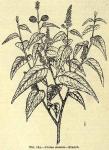 311. CASCARILLA, N.F.—CASCARILLA BARK. The bark of Cro'ton elute'ria Bennet. Small broken quills having a grayish fissured cork, more or less covered with white lichen patches, but often partially or wholly removed, showing the dull brown inner bark; inner surface smooth; bast fibers few; fracture short, resinous; odor feeble, stronger when rubbed; when ignited, it emits a strongly aromatic odor, somewhat resembling musk, but weaker and more agreeable; taste warm, aromatic, very bitter. Copalchi bark (see also Aspidosperma, 353) has a cascarilla-like odor, and melambo bark, from Croton Melambo, Venezuela, and other species of Croton, are similar to cascarilla.
311. CASCARILLA, N.F.—CASCARILLA BARK. The bark of Cro'ton elute'ria Bennet. Small broken quills having a grayish fissured cork, more or less covered with white lichen patches, but often partially or wholly removed, showing the dull brown inner bark; inner surface smooth; bast fibers few; fracture short, resinous; odor feeble, stronger when rubbed; when ignited, it emits a strongly aromatic odor, somewhat resembling musk, but weaker and more agreeable; taste warm, aromatic, very bitter. Copalchi bark (see also Aspidosperma, 353) has a cascarilla-like odor, and melambo bark, from Croton Melambo, Venezuela, and other species of Croton, are similar to cascarilla.
Constituents: Volatile oil (1.5 to 3 per cent.); cascarillin (a bitter crystalline principle), tannin, fat, resin, etc. Aromatic, stimulant, and tonic. Once used as a febrifuge as a substitute for cinebona. Dose: 15 to 30 gr. (1 to 2 Gm.).

